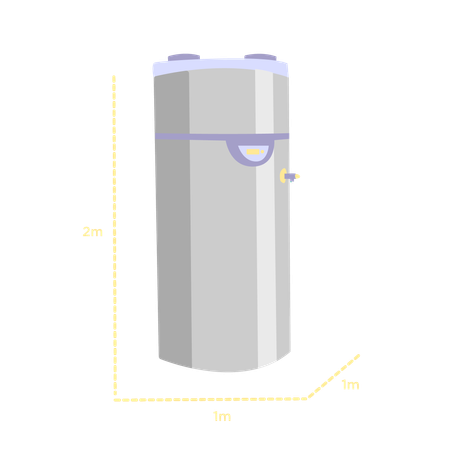Hot water cylinders: everything you need to know
Like two peas in a pod, a hot water cylinder works in tandem with your air source heat pump to keep your home cosy and your water warm. In this guide we explain everything you need to know about the hot water system installed with a heat pump, and how to get the most out of the water you have stored. Let’s dive in!

Why do you need a hot water cylinder?
Unlike combi boilers, which provide your space heating (via radiators or underfloor heating) and hot water at the same time, heat pumps are designed to do one or the other at a time. This means your home will need a cylinder to store your hot water so it can spend more time heating your home. But don’t worry, this doesn’t take long! A 9kW heat pump can reheat a 200L cylinder from 10ºC to 50°C in about an hour.
Why does the size of the cylinder matter?
Cylinder are sized in litres based on the overall volume of the tank. Inside each cylinder is a coil of pipe that heats up the stored water.
The water inside that coil flows to and from your heat pump and therefore can’t be used at the tap. So we subtract a bit for the coil (15L is a good rule of thumb) to determine the available water for a given cylinder size.
What is usable hot water and how much will I have?
Cylinders store hot water most efficiently at 48-50°C. You won’t want the water to come out of the tap at that temperature as it’s too hot! Usable hot water is recommend at 40ºC for safety and comfort. To get usable hot water at 40ºC from a cylinder of 48ºC water, the water from your cylinder will be mixed with cold mains water at your kitchen or bathroom taps.
For 48ºC cylinder water and a typical mains temperature of 10ºC, you’ll mix them at a 4:1 ratio to make nice, steamy 40ºC usable water for your bath or shower. In practical terms, that means the hot water stored in your cylinder goes 20% farther at the tap!
If you keep your cylinder at 50ºC or more, you’ll get just a bit more usable water. And if you like your water above 40ºC at the tap (for you hot shower fans 🥵) you’ll get a bit less usable water. Find guidance on how to set a schedule for your hot water here.
Which cylinder is right for you?
We’ve included the table below as a guide to what you can expect out of the cylinders size we install.
| 2-3 people | 2-4 people | 3-5 people | 4-6 people | |
|---|---|---|---|---|
| Cylinder size | 180L | 200L | 250L | 300L |
| Available water | 160L | 180L | 230L | 280L |
| 40ºC Usable Water | 200L | 225L | 285L | 350L |
| 10-minute showers at 40°C | 2 | 2-3 | 3-4 | 4 |
| Full baths at 40°C | 1 | 1 | 2 | 2-3 |
| Continuous hot water 40°C & 8L/min | ~25 mins | ~25-30 mins | ~35 mins | ~40 mins |
| Cosy 6 reheat time 10°C - 48º C | ~70 mins | ~80 mins | ~100 mins | ~125 mins |
| Cosy 9 Reheat time 10°C - 48º C | ~45 mins | ~50 mins | ~65 mins | ~80 mins |
How far your cylinder water will go on a daily basis depends mostly on how you use it. For a 10-minute shower, you’ll use around 80L of 40°C hot water, while bath uses 100-120L of 40ºC hot water.
How much space will the cylinder need?
Cylinders can take up more space than you expect. Generally speaking, if the cylinder location you have in mind can fit a full size fridge-freezer, it should work. There are many suitable locations, but typical spaces include airing cupboards, garages, utility rooms, lofts (subject to weight limits and a structural survey, which may cost extra) and some crawlspaces (although the space also needs to accommodate the people who will be installing it as well, and anyone who may need to repair it in the future!).
A cylinder isn’t the only thing we’ll be installing in your home. A full system includes the additional components listed below, plus all the necessary pipework and electricals. These also require space and can influence where we are able to install your cylinder. Where we are limited by space, our installers may be able to install some of these components in a different location. We generally confirm this during your survey, but this is subject to change during the installation as needed.
Other components we’ll fit in your home
A. Expansion vessels Specialised small tanks (about the size of two footballs) that help maintain system pressure. We’ll fit one in your home for a Cosy and two for other models of heat pump.
B. Volumiser (or buffer) Medium sized tank (about the size of a golf bag) that holds extra water for various system functions (we use the same tank whether it’s configured as a volumiser or buffer)
C. Pumps and valves Depending on the layout of your home and your heating system, we’ll install one or more valves. We’ll also install pumps if needed (though most homes don’t require this).
Below are photos from real customer homes showing what a complete system might look like inside your home, with labels to help you visualise each component.




Hey I'm Constantine, welcome to Octopus Energy!
×Close window